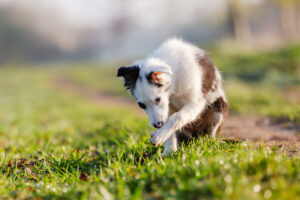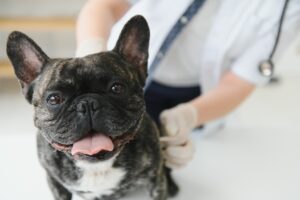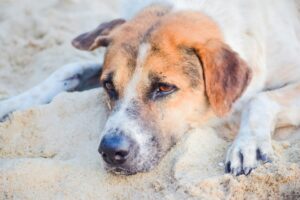Dogs can get poison ivy, which can spoil their outdoor adventures and even affect their time in your backyard. Poison ivy might be growing in your yard without you knowing it. So, it’s important to recognize what poison ivy looks like and take steps to avoid it to protect your dog.
In this post, we’ll show you how to identify poison ivy, its effects on dogs, and how your dog can get relief from exposure.
What Makes Poison Ivy Poisonous to Dogs?
Poison ivy produces an oil called Urushiol. Other plants that produce this oil are poison oak and poison sumac. Urushiol is what causes itching upon contact with the plant.
If it’s any comfort, humans are more prone to having a poison ivy reaction than dogs. Your dog’s fur provides some protection against this oil, although areas with thin or no fur, such as the belly, paws, face, and ears, are still at risk of irritation.
Some dogs are also more prone to having poison ivy reactions than others. Hairless breeds like the American Hairless Terrier and Chinese Crested are at more risk of developing a rash from contact with the plant. Also, shorter dogs like Dachshunds will easily get the oil on their bodies than taller dogs.
Dogs with thin fur, like greyhounds and Dalmatians, may also be more prone to reacting to poison ivy. Hunting dogs, farm dogs, and dogs that spend a lot of time outdoors are at higher risk of exposure to poison ivy.
How Do I Know It’s Poison Ivy?
To recognize poison ivy on contact, look for the following features:
- Leaf Arrangement: Poison ivy typically has clusters of three leaflets per stem. The saying “Leaves of three, let it be” can help you remember.
- Leaf Shape: The leaflets can be smooth, lobed, or toothed. The middle leaflet usually has a longer stem than the two side leaflets.
- Color: The leaves are green in the spring and summer but can turn red, orange, or yellow in the fall.
- Surface: The leaves can have a shiny or glossy appearance due to the urushiol oil.
- Growth Pattern: Poison ivy can grow as a vine, often seen climbing trees or walls, or as a low shrub. When it grows as a vine, it may have hairy roots attached to surfaces.
- Berries: Poison ivy produces small, white, or cream-colored berries that grow in clusters. The berries are poisonous to dogs and humans and also contain urushiol.
- Location: Poison ivy is commonly found in wooded areas, along trails, riverbanks, and even in urban environments.
By paying attention to these characteristics, you can better identify and prevent your dog from coming in contact with poison ivy.
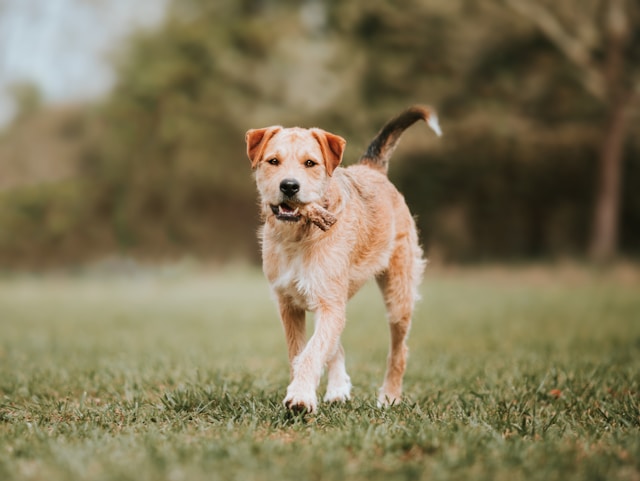
What Are the Signs That a Dog Has Poison Ivy?
Here’s what to watch out for if you suspect your dog might have come in contact with poison ivy:
- Intense Itching: This is often the first and most noticeable symptom.
- Redness and Swelling: The affected areas will become inflamed.
- Hives or Blisters: These may develop in severe cases.
Note: Symptoms typically appear 3-7 days after exposure.
If you suspect your dog has eaten poison ivy, watch out for:
- Abdominal pain
- Vomiting
- Diarrhea
- Swelling of the mouth or throat
- Difficulty breathing (in severe cases)
If your dog shows any of these symptoms, especially difficulty breathing, seek immediate veterinary care. Remember that early detection and treatment are crucial for your dog’s comfort and well-being.
What Are the Risks of Poison Ivy for Dogs and Humans?
Excessive scratching or biting at specific areas is often the first sign of poison ivy in dogs. Surprisingly, dogs might show no outward signs of a poison ivy reaction. However, they can still carry the irritating oil, urushiol, on their fur. This poses a risk to humans as we’re more susceptible to its effects.
Most people develop a rash after exposure to a tiny amount of urushiol. According to the National Institute for Occupational Safety and Health (NIOSH), when exposed to 50 mcgs of urushiol, an amount that is less than one grain of table salt, 80 to 90 percent of adults will develop a rash.
The rash itself is not contagious. But if you or your dog scratch the blisters, bacteria underneath your fingernails or on your dog’s paws can lead to an infection.
If you suspect your dog has had contact with poison ivy, avoid close contact until the issue is resolved. Wash your hands thoroughly after petting or grooming your dog. Remember, even a small amount of the oil can cause a reaction.
What Do I Do If My Dog Has Poison Ivy?
If your dog has come in contact with poison ivy, it will be hard to see it in pain and discomfort. There are things you can do to quickly reduce the effects of the plant on your dog. Here are a few tips:
- Get Rid of the Oil: First things first, bathe your dog in cool or warm water with a natural shampoo, ensuring you pay attention to areas that you’ve seen it scratch. These are most likely going to be where it has thin fur. Be careful to protect yourself from coming in contact with the oil as well. Be sure to wear waterproof gloves and long sleeves while giving your dog a bath.
- Rinse Thoroughly: Ensure all shampoo is properly rinsed off to avoid further irritation.
- Apply Topical Treatments: Cool compresses, chamomile tea, apple cider vinegar, oatmeal bath and other topical treatments can help soothe your dog’s itchy skin.
- Disinfect Your Home: Urushiol oil can transfer from your dog’s fur to your furniture, clothes, and other areas in your home. Clean things and surfaces your dog has come in contact with. Don’t forget to also wash your dog’s bedding, toys, leash and collar thoroughly.
How Do I Prevent Poison Ivy Exposure for My Dog?
- Get Rid of the Plant: Learn to identify the plant and remove them from your surroundings. Burning them is not advisable as that releases the oil into the air. If you or your dog inhale it, it can be harmful.
- Keep Your Dog on a Leash: When walking in wooded or overgrown areas, keeping your dog on a leash can prevent them from wandering into poison ivy.
- Regular Grooming: Regularly grooming your pup can help you spot any potential irritants early and keep your dog’s fur free of them.
- Let Your Dog Wear Protective Clothing: Putting your dog in a shirt or any protective wearing can help shield him from contacting poisonous plants while outside for a walk.
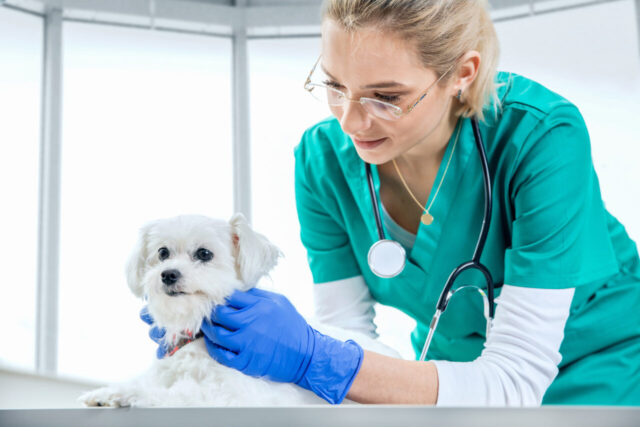
When to Take Your Dog to See a Vet
While you can manage mild cases of poison ivy at home, seek vet care if:
- Your dog is in a lot of distress or pain.
- Your dog has severe wounds from scratching and biting the itchy areas.
- Symptoms persist for more than a few days.
- There are signs of severe allergic reactions such as difficulty breathing or widespread swelling.
What Can Truffle Paws Do to Help?
At Truffle Paws Pet Insurance, we understand that your pet may experience hazards outdoors, including poisonous plants like poison ivy. And it’s normal for you to be concerned about the risks and whether pet insurance covers treatment for exposure to such plants.
Truffle Paws Pet Insurance provides coverage for vet expenses related to accidental injuries and illnesses, which typically includes treatments for allergic reactions and skin conditions caused by plant exposure.
At Truffle Paws, we’re happy to support you in providing the best care for your furry companions. When you know that unexpected veterinary expenses, including those related to poison ivy exposure, are covered with comprehensive pet insurance and won’t burn a hole in your pocket, you’ll have peace of mind.
To learn more about our pet insurance coverage and how we can help protect your pet’s health, visit our website or contact our customer service team today. We’re here to assist you in keeping your pet safe and healthy throughout their outdoor adventures.



